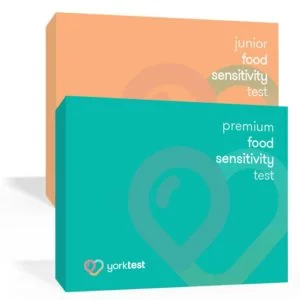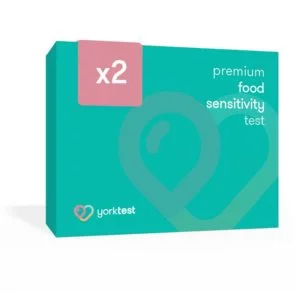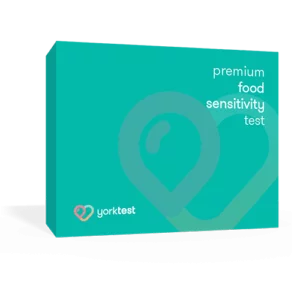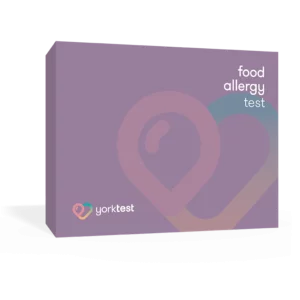- Food Sensitivity vs. Food Intolerance vs. Food Allergy
- Defining Food Sensitivity, Food Intolerance and Food Allergy
- So, What is a Food Sensitivity?
- How to Test for Food Sensitivity
- Elimination Diet
- Blood Test
- How is a Food Sensitivity Blood Test Done?
- What Can a Food Sensitivity Test Tell You?
- Are At-Home Food Sensitivity Tests Reliable?
Food sensitivities is a commonly used catchall term to describe a spectrum of adverse reactions following food ingestion, including food intolerance, food allergy, or food sensitivity.
Despite the generalized use of this term, there are different and unique sets of biological mechanisms and symptoms that can occur such as:
- Enzyme deficiencies and digestive problems e.g. FODMAP, fructose or lactose malabsorption
- Pharmacological responses e.g. caffeine sensitivity
- Immune system reactions e.g. immunoglobulin E (IgE) and immunoglobulin G (IgG) responses
It has been estimated that food allergies (IgE reactions) alone affect 32 million people in the US1. When you theninclude those with food intolerances and food sensitivities as well, this equates to many more people having adverse reactions to the food they eat.
Food Sensitivity vs. Food Intolerance vs. Food Allergy
In defining what is really meant by food sensitivities, it’s important to first call out that food allergyand food intoleranceare both defined by specific reactions:
- Food intolerance is a term that is usually used to describe the discomfort associated with the inability to digest certain foods, which is often attributed to an enzyme deficiency2 (e.g. lactose intolerance).
- Food allergy, on the other hand, is a more severe immune system response involving IgE antibodies. The body sees the food as a threatening invader, causing serious and sometimes life-threatening reactions. In this case it is vital that medical attention is sought immediately.
When symptoms arise that cannot be directly attributed as an allergy or intolerance, the condition is often generalized as food sensitivity.
Although there’s debate around what’s actually happening in a person with food sensitivity, according to Harvard it appears that specific foods create an immune reaction, involving IgG antibodies, that can produce a spectrum of symptoms.
Defining Food Sensitivity, Food Intolerance and Food Allergy
At YorkTest, we define food sensitivity, intolerance and allergy based on the main symptoms, common triggers and the testing methods used to identify each condition:
| Food Sensitivity | Food Intolerance | Food Allergy | |
| Symptoms | IBS, bloating, diarrhea, constipation, digestive, migraines, headaches, skin symptoms, low energy, low mood, rhinitis, sinusitis, etc. | Diarrhea, nausea, and sometimes vomiting, stomach cramps, bloating, gas | Swelling, itching, vomiting, diarrhea, anaphylaxis, potentially fatal |
| Common triggers | Any food that contains larger molecules such as proteins. Examples include milk, eggs, yeast but also things that you wouldn’t normally think about such as lentils, fruits, vegetables, coffee, chickpeas, etc. | Lactose (milk sugar) | Peanuts, milk, eggs, tree nuts, shellfish, sesame |
| Testing | Food-specific IgG blood testing – YorkTest helped pioneer this with the development of our Premium Food Sensitivity Test method in the 1990s | Hydrogen breath testing | Medical attention required – food-specific IgE blood test, skin prick testing, oral challenge, etc. |
So, What is a Food Sensitivity?
Considering everything we’ve discussed so far, the most important characteristic of a food sensitivity reaction is the type of immunoglobulins being triggered.
- With food sensitivity, immunoglobulin G (IgG) is the antibody that’s triggered.
- Whereas with food allergy, immunoglobulin E (IgE) antibodies are the primary trigger, which typically cause more serious symptoms.
Without understanding these differences, it’s easy for individuals to be confused about the nature of their food-related condition. This confusion also highlights the need for proper testing.
While food sensitivity symptoms are typically not life-threatening, they can still disrupt an individual’s quality of life in many ways. Plus, because there’s such a multitude of symptoms, learning how to detect and manage a food sensitivity can be a challenging matter.
A food sensitivity test can help determine the food sources that might be contributing an individual’s negative reaction. Helping to identify the cause of the response is crucial to knowing which dietary therapies are most effective.
How to Test for Food Sensitivity
There are several ways you can test for food sensitivity, from elimination diets to comprehensive blood panel tests.
Elimination Diet
This method is rooted in careful observation and experimentation with one’s food choices. It works by eliminating certain foods that are believed to trigger reactions for 2 to 4 weeks, and later reintroducing those foods one by one.
An elimination diet is still a reliable and low-tech approach to try and pin down what may be causing the problematic symptoms. However, it is virtually impossible to guess which foods to eliminate and this a time-consuming process. Plus, it can be difficult to identify sensitivities to ‘hidden’ foods which are commonly used as a coloring / flavoring within other foods, like beets or agave, using this method alone.
Blood Test
Another method for food sensitivity testing is to test a specimen sample, namely blood. Note that some companies offer hair testing for food sensitivity but there is no basis in science for hair testing for food sensitivity. Blood testing on the other hand offers a robust solution by checking IgG levels in response to various foods.
Food sensitivity blood tests are designed to analyze IgG antibodies, which are proteins within the immune system that can help neutralize threats like parasites and viruses, but that can also trigger inflammation and symptoms. It is not normal to have high levels of food IgG antibodies in your blood and fighting off foods that are triggering an IgG reaction can leave us depleted in energy.
How is a Food Sensitivity Blood Test Done?
For a food sensitivity blood test, the blood sample should be analyzed in a credible laboratory.
In the past, such blood tests would be carried out at a local medical clinic, hospital, doctor’s office, or phlebotomy center (a dedicated clinic for taking and testing blood samples). However, food sensitivity testing can now be done with at-home blood collection kits through a certified laboratory provider.
For example, food sensitivities can be detected with YorkTest’s Premium Food Sensitivity Test, a home to laboratory testing kit that only requires a few drops of your blood.
Once your blood sample arrives at the lab, the test works by measuring the amount of IgG antibodies found in the blood for each type of food under consideration.
Unlike some at-home food sensitivity test kits on the market, YorkTest takes into account all four subtypes of food-specific IgG (1-4), while others only test for IgG4. Comprehensive lab testing across all four immunoglobulin G antibodies is significant in detecting the various IgG reactions to foods that may be present.
The beauty behind this form of food sensitivity testing is that it’s both accurate and convenient, allowing anyone to collect a small blood sample within minutes from the comfort of their home:
- You’ll receive an easy-to-use at-home test in the mail, which includes instructions and everything you need.
- After collecting a small blood sample, you’ll simply send your kit back to YorkTest’s accredited laboratory for testing.
- Once your blood sample has been analyzed, you’ll receive your test results within 7 days in a comprehensive and secure online report, along with follow-up support and guidance to navigate any food reactions you may have.
What Can a Food Sensitivity Test Tell You?
A food sensitivity test can provide a wealth of information to help those with specific IgG reactions to foods lead better lives.
When testing across all four subtypes of IgG, your blood sample will be tested for reactions to over 200 food and drink ingredients, some of the most common types include:
- Nuts, seeds, and legumes (almonds, cashews, peanuts, brazil nuts, walnuts, coconut, chickpea, sesame seed, sunflower seed, flax, hemp, kidney bean, lentils, soybean, and cocoa bean)
- Fruit (apple, avocado, blackberry, blueberry, cherry, cranberry, goji berry, grapefruit, kiwi, lime, mango, orange papaya, peach, pear, pineapple, pomegranate, prune, raspberry strawberry, and tomato)
- Vegetables (asparagus, beets, broccoli, Brussel sprouts, carrot, cucumber, eggplant, kale, lettuce, onion, mushrooms, peppers, potato, rhubarb, spinach, sweet potato, and turnips)
- Herbs and Spices (anise, basil, bay leaf, cardamom, chili pepper, cinnamon, coriander, cumin, curry, dill, garlic, ginger, jasmine, juniper, lemongrass, mint, mustard seed, nutmeg, paprika, parsley, peppercorn, saffron, sage, thyme, turmeric, vanilla)
- Grains (buckwheat, wheat gluten, corn, hops, malt, millet, oats, quinoa, rice, spelt, and wheatgrass)
- Fish and Shellfish (anchovy, cod, crab, eel, haddock, herring, lobster, mackerel, mussel, oyster, prawn, salmon, sardines, scallops, shrimp, sole, trout, and tuna)
- Meat (beef, chicken, duck, goat, lamb, pork, turkey, and venison)
- Other common foods and ingredients (coffee, dairy, egg white, egg yolk, tea, grape/wine, yeast)
We recommend taking a food sensitivity blood test first to identify the foods you are showing an IgG reaction to. Then, work with a Nutritional Therapist to develop an elimination diet program if needed.
Please remember that IgG antibody levels in response to certain foods cannot be used as an indicator of potential food allergies.
The FDA has identified eight major food allergens which account for 90 percent of serious allergic (IgE) reactions. They include wheat, milk, eggs, fish, shellfish, peanuts, tree nuts, and soybeans. Sesame is also a rising food allergen in the US.
Are At-Home Food Sensitivity Tests Reliable?
One of the most common questions concerning at-home food sensitivity tests is how accurate and reliable the results are.
As mentioned above, some test kits only analyze the IgG4 antibody, which poses some limitations to the test results. However, tests that cover all four IgG antibodies provide more comprehensive and reliable outcomes.
Many scientific studies support the reliability of food sensitivity blood tests5 that analyze these IgG antibodies. This form of at-home blood testing proves to be reliable in pinpointing degrees of IgG food reactions.
The Premium Food Sensitivity Test from YorkTest has been shown to be accurate and reliable. The reproducibility rate of YorkTest’s home to laboratory testing service is over 98%.
This means that when two samples are taken from the same person at the same time and both samples tested, the results will correlate with each other more than 98% of the time.
If you’re interested in taking the test; learn more about the test or read case studies from other individuals who have taken the test.
Scientific References:
1. https://www.foodallergy.org/resources/facts-and-statistics
2. Tuck CJ, Biesiekierski JR, Schmid-Grendelmeier P, Pohl D. Food Intolerances. Nutrients. 2019 Jul 22;11(7):1684. doi: 10.3390/nu11071684. PMID: 31336652; PMCID: PMC6682924.
3. Almario, Christopher V et al. “Burden of Gastrointestinal Symptoms in the United States: Results of a Nationally Representative Survey of Over 71,000 Americans.†The American journal of gastroenterology vol. 113,11 (2018): 1701-1710. doi:10.1038/s41395-018-0256-8
4. Waserman, S., Bégin, P. & Watson, W. IgE-mediated food allergy. Allergy Asthma Clin Immunol 14 (Suppl 2), 55 (2018). https://doi.org/10.1186/s13223-018-0284-3
5. Hardman G and Hart G (2007) Dietary advice based on food-specific IgG results. Nutrition & Food Science 37:16-23 Hardman G and Hart G











